Navigating the Labyrinth
Zen Training: A Structured Approach
By Martin Goodson
 From its inception The Zen Centre has adopted the symbol of the labyrinth to denote the navigation of the spiritual path. It is an ancient symbol that was used to symbolise the non-linear route that a spiritual training can take.
From its inception The Zen Centre has adopted the symbol of the labyrinth to denote the navigation of the spiritual path. It is an ancient symbol that was used to symbolise the non-linear route that a spiritual training can take.
Having been something of a ‘spiritual seeker’ for a number of years before making contact with Ven. Myokyo-ni and The Zen Centre, I had always felt frustrated by a certain incoherence when it came to knowing exactly what a spiritual practice entailed. Therefore, it was most refreshing to hear Ven. Myokyo-ni say that The Zen Centre offered ‘a structured training’ to follow. “At last!” I thought, “Here is someone who will just tell me what I am supposed to be doing!”
It was made clear that following a tradition meant that the signposts for the path had been well laid out, with pitfalls marked and encouragements when energy and motivation were flagging.
As we begin to move back to ‘in-person’ meetings, picking up from where we left off in March last year, it is a good time to refresh just what being a member of the Zen Group means, what is on offer and provide a few thoughts for Zen students who want to go deeper into the training.
When Irmgard Schloegl (later ordained as Ven. Myokyo-ni), returned from Japan in 1972 she led a Zen class held at The Buddhist Society which, to start with, only taught ‘daily life practice’, the practice of Zazen was introduced later. This was to emphasise the importance of daily life practice and that Zazen is built on this practice.
As the class grew it was decided to divide the classes into ‘introductory’ and ‘main group’ classes. The purpose for this was to provide stability for the growing size of the main group. This also allowed new people to try out a few Zen classes to see if it suited without disrupting the dynamic of the main group with a constant inflow of new people. This model has worked very well and has been kept up until today.
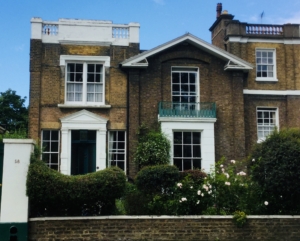
Shobo-an Zen Temple at 58 Marlborough Place
Classes started at 58 Marlborough Place, then Christmas Humphreys’ home, in the late 1970s, the premises becoming Shobo-an in 1984 when the Temple was inaugurated and Ven. Myokyo-ni ordained.
‘New’ members now join from several streams, there is still the Monday introductory class which is held at The Buddhist Society, there is also the Zen Sunday – a monthly class for those living out of London. These classes are both expected to become ‘blended’ in person and on Zoom classes. There are those who join the satellite Zen groups held by Zen members in some European countries and in England. This allows people to settle into both daily life practice and zazen. Once the class leader feels that the practitioner is settled then an invitation is extended to join the ‘main group’ and engage in additional activities and further study and practice to deepen the training.
For those in London, there are the so-called ‘main group’ classes at The Buddhist Society (Tuesday/Friday) and at Shobo-an (Monday/Wednesday). Some of these have been held online and are expected to become blended classes in the Autumn.
There are also classes at Fairlight in Luton for those in the vicinity (Please call or email Ven. Sogen/Myosui for more details). These classes provide an opportunity to talk to Zen teachers about any difficulties which may be arising in daily life practice or zazen. They also allow the teacher to point towards exploring the ‘insight’ practice, which along with meditation and the discipline of the daily life practice makes up “The Three Pillars of Buddhist Practice”.
For those unable to come to the London classes or to attend a nearby group we offer the monthly letter writing group. This requires a letter/email once a month from the student about how the practice is going and any difficulties or questions that may be arising. A reply from a teacher along with a monthly theme on some aspect of daily life practice is then sent. The student reads this several times throughout the following month and then writes another letter/email to be sent before the end of the calendar month. This is an ongoing exercise that forms part of the insight practice for the Zen training.
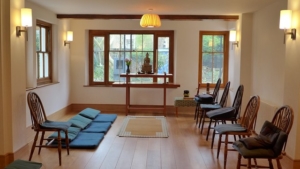
The Zendo (meditation hall) at Shobo-an
Once this phase had been settled in, then students are encouraged to begin to attend sesshins/retreats. There are one-day, weekend residential, and five-day residential sesshins. Sesshins are quite literally opportunities to ‘retreat’ from the ordinary demands of life, to collect the heart, to deepen zazen and insight practice as well as to hear Dharma talks, quite often around a theme or text – as study and practice are the two legs which take the practice forward.
The devotional side of the training – which aims to develop warmth of heart and appreciation and gratitude for the lineage – is practised by attendance at the Memorial days for the old masters. These services comprise the Zen Centre’s full daily chanting and a short Dharma talk on the life of the master in question. The days and times can be found at the back of Zen Traces – our in- house journal – and on the website.
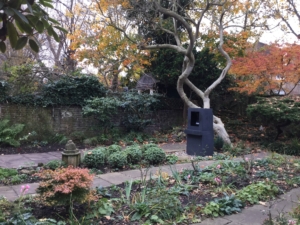
The garden at Shobo-an
Our two temples, Shobo-an, in North London and Fairlight, in Luton, provide an opportunity for students to ‘try out’ life in a temple. As one of the schools of Mahayana, the Zen school offers the same training for the ordained and laity alike. However, just as sesshins provide for a more intense effort, so do periods of time – short and long – living in the temple as a ‘resident’. Not only the added discipline of the form but also the atmosphere can produce a transformation of heart, strengthening of resolve and realisation of those things that are truly important in the life of the student. By stripping away many of the distractions ‘I’ likes to accumulate, the inner light can begin to truly shine forth and fulfil its role as a life-guide.
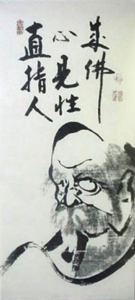
Bodhidharma, the first Zen patriarch
A special transmission outside the teachings,
Not dependent on words and phrases.
Directly pointing to the human heart,
Seeing into its nature and awakening.
This verse famously attributed to the First Patriarch Bodhidharma encapsulates the spirit of Zen and is also easily misunderstood. It follows the process of understanding through to full realisation. Far from eschewing study it points out that ‘head-knowledge’ is not enough, what is learned in the scriptures must be realised in this very body. However, for those of us to whom Buddhism is not a native faith, we need to become familiar with the framework the Buddha laid down during his 45-year teaching life. Hence a course of study is also necessary. For some, there is an addiction to study, for others it can become all about “zazen and satori”. Both of these show the grasping heart – the one-sidedness of ‘I’. So there is also a judicious programme of study and practice.
To start, prior to joining the introductory class, or in tandem with it, students are advised to acquaint themselves with the basic teachings of The Buddha. This can be done via The Buddhist Society’s Introduction to Buddhism course currently held online or via its mail-service Correspondence Course which covers the same material. Once a person has settled into one of the main classes for a year or two it is strongly advised that they attend the Society’s ‘First Turning of the Wheel’ course. Another year or two later there is the Themes of the Great Way Mahayana course. Together, these courses give a firm foundation and some history of the development of the Buddhist teachings that underpin the Zen lineage.
Attendance at the Zen seminar, in July, and the sesshins will provide students with the teachings, stories and anecdotes of the Zen masters and here too some book recommendations may be useful for individual study. The Zen Centre’s own publications are an obvious starting point.
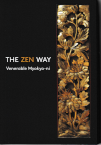
The Zen Way by Venerable Myokyo-ni
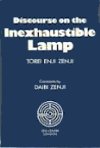
Discourse on the Inexhaustible Lamp by Torei Enji Zenji
The Zen Way and Gentling the Bull being the first two recommended to all beginners – though frequent revision is fruitful at all stages of the training.
Master Torei’s ‘Discourse on the Inexhaustible Lamp’ charts the training of the Zen student from start to finish and has much else besides. It is not an easy work but that should not put the serious student off, rather see it as a challenge! The other texts published by The Zen Centre and the classic Record of the Transmission of the Lamp translated by Randolph Whitfield are also available from The Zen Centre Website – https://rinzaizencentre.org.uk/publications/ -.
For those with aptitude and a calling there is also the possibility of learning to give Dharma talks. This is invaluable for those invited to contribute to sesshins, or lead classes and for those who are running satellite affiliated groups. Once a month there is a Dharma Talk evening streamed from Shobo-an where contributors will be given a theme and a month to prepare a short talk to be delivered at the next evening. Members of the group are welcome to attend so that speakers get used to talking to an audience. Feedback will be given. If you would like to attend as part of the audience online or in person, please contact Shobo-an.
All in all there is plenty for everyone. The Lotus Sutra talks of the ekayana – the one way which is a staged way from the beginner whose curiosity is aroused by an inner prompting to begin the spiritual search, to a fully rounded human being dedicated to be of service to all sentient beings. We very much hope that the light that Ven. Myokyo-ni brought from Japan will be carried forward for those in the future whose hearts also incline towards it. For that, we rely not just on a few willing to pass on the lamp through dedicating their lives, but to all of us willing to walk the Buddha’s Way within our own means and circumstances.
This article featured in the September 2021 edition of Zen Traces (volume 43 Number 4 p466-p469)
